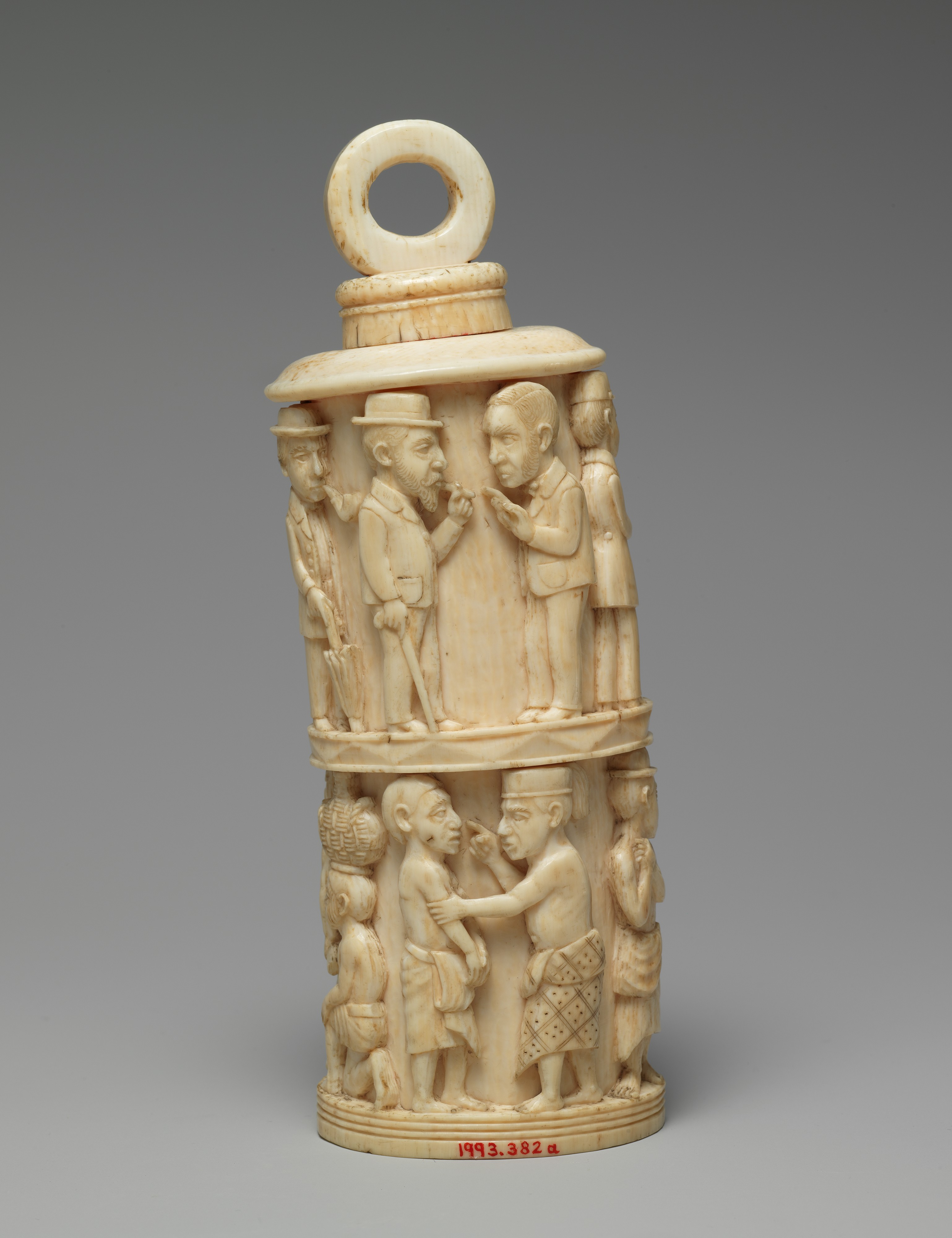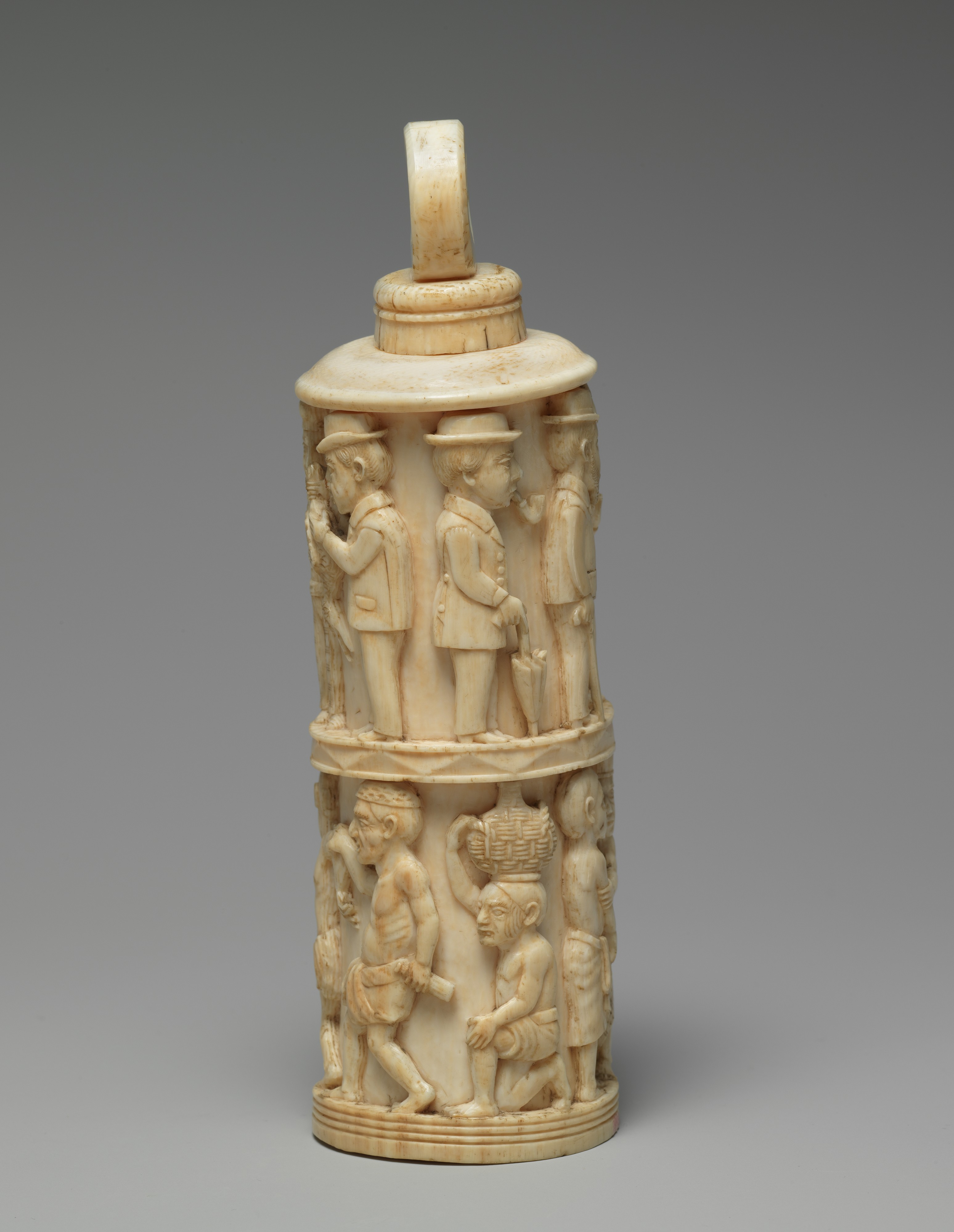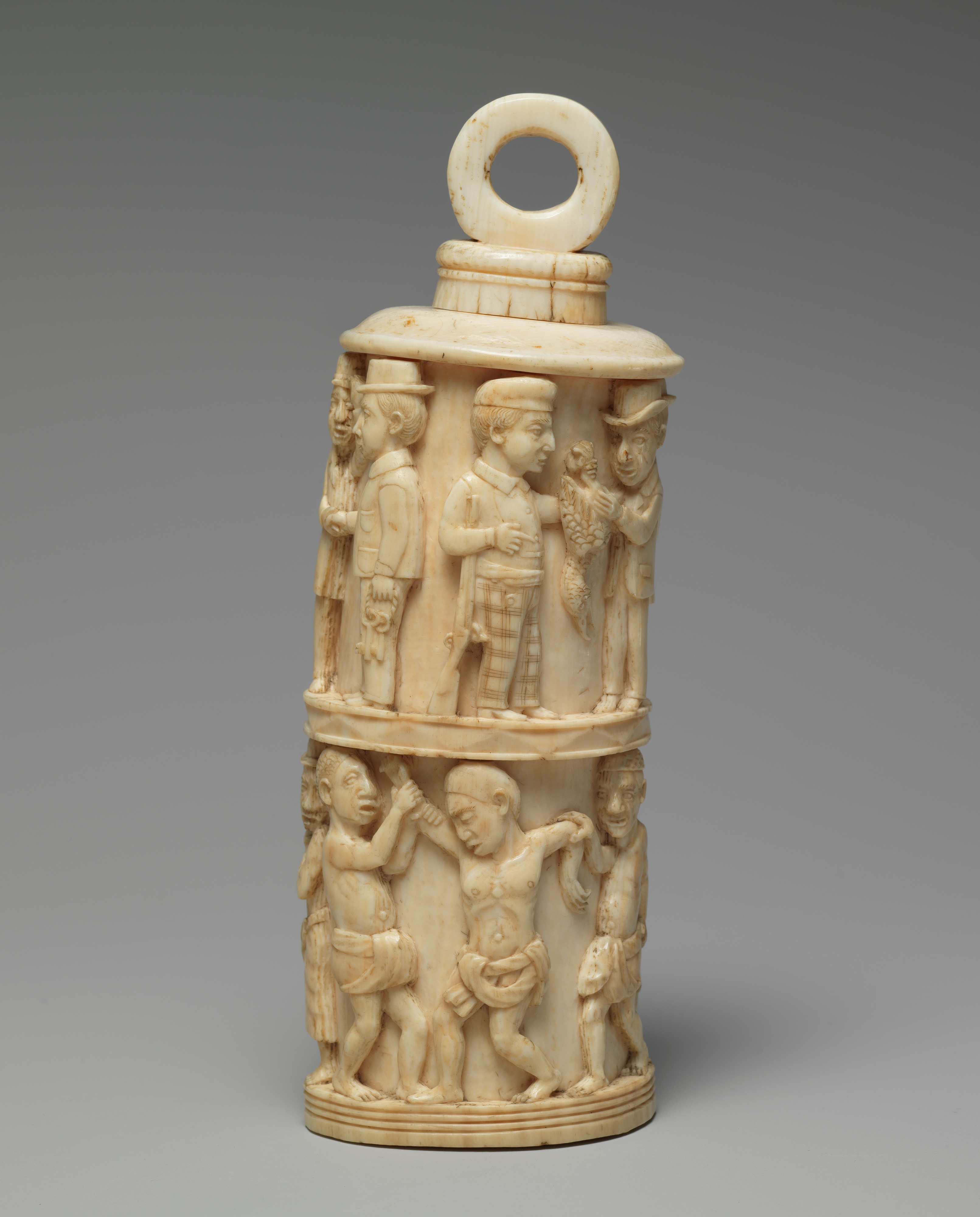Receptacle with Figurative Relief and Stopper
Not on view
This hollow columnar container was most likely carved from the lower extremity of an ivory tusk, the natural curve of which defines the structure. The container has a hole at the top into which an undecorated circular ivory stopper, with an upright circular handle, has been set. Male figures are carved in relief around the surface of the container in two clearly demarcated registers: Europeans at the top, Africans at the bottom. The sculptor has depicted each figure in exacting and minute detail, paying special attention to facial features, clothing, and objects carried. Individuals are presented in a series of groups as if caught in action. Their placement around the tusk increases this sense of dynamism and interaction. Diminutive in scale, it is likely this container was intended to be held in the hand and turned in order to view all the figures. The majority of Loango souvenir ivories consist of a full tusk complete with a figurative relief along the entire surface, making this work unusual in the corpus. The arrangement of figures interacting within a defined space along a vertical axis is, however, consistent, leaving open the possibility that this might be a fragment from a whole tusk later modified into a container.
The Vili are a Kongo peoples of the Loango coast who were historically celebrated as traders and sculptors, renowned regionally for their ivory carving and for the creation of potent minkisi or power figures. Carved by a master Vili sculptor, whose superior handling is apparent in other extant works attributed to him, this receptacle was intended as a souvenir for a European client passing through one of the numerous trading posts that sprung up along the Loango coast in the second half of the nineteenth century. These European settlements, located at the mouths of rivers and near natural ports, helped to facilitate the export of raw materials such as rubber, palm oil, copper, and ivory from the continent.
Some dozen individual artists' hands and stylistic groups have been identified in the corpus of Loango souvenir ivories. Using basic European tools including chisels, sculptors drew on a wide range of sources material in these works, ranging from indigenous fables to European printed matter. As can be seen in this example, scenes drawn directly from everyday life in one of these commercial centers, familiar both to the artist and his client, were also often depicted.
In the top register, seven well-dressed European men engage in acts of commercial exchange. A man wearing checked trousers, a collared shirt, and a flat cap, with a flintlock rifle positioned in the crook of his right arm, is seen handing over a dead waterfowl to a man in a top hat and coat. Behind this figure, and facing in the opposite direction, drawing the viewer around the surface of the ivory, stands a man with an umbrella in his right hand and a pipe in his mouth. He is directly behind a man dressed in a tail coat with a high lapel and large buttons. In front of this individual (now on the opposite side of the ivory from the waterfowl exchange) is a bearded man who holds a cigar to his mouth with one hand, a cane in the other, and leans slightly forward in conversation with a bareheaded man reading from a document. A well-dressed European holding a set of keys stands apart from the rest. Defined by the clothes they wear and the objects they carry, the sculptor shows trade as being conducted in an orderly fashion among European men of a similar high rank.
In the bottom register, occupied exclusively by African individuals, a different universe is depicted; violent exchange is the defining principle. The main scene shows a man being forcibly restrained by both arms. Wearing a simple loincloth and with his arms outspread and head fallen against his chest, he is reminiscent of figures of Christ produced in the Kongo region since the late fifteenth century. His right arm is grasped by a bareheaded individual who looks away. His left arm is held by a man with his mouth open in an aggressive smile who grips a gin bottle, possibly indicating he is drunk. This man wears an mpu, a Kongo crown of leadership made out of knotted raffia or pineapple fiber, symbolic of his authority. Behind him cowers an indentured laborer, or slave, kneeling beneath the weight of the large calabash water container on his head, the basketry covering minutely rendered by the sculptor. On the side of the ivory opposite from this capture scene, another act of aggression is unfolding. A man wearing a fez hat with a feather at the back and an elaborate sarong with a checked pattern threatens an individual of lower rank, holding him by the arm and pointing a finger at his face.
The trade of the dead bird between the two Europeans sits directly above the African capture scene, making a subtle equivalency. The European traders who lean in to make a deal are positioned above a confrontation scene between two African men. Although the sculptor grants the European protagonists the physical distance from Africans that they fought hard to maintain in these commercial centers of the late nineteenth century, the sculptor unflinchingly implicates them in the violence of the Atlantic trade, looking back to the transatlantic slave trade. Those who hold the umbrellas and the walking sticks, the guns and the keys, are undoubtedly those in charge. The Vili sculptor who carved this work, and who came out of a celebrated tradition of ivory carvers in the region dating back to at least the sixteenth century, sends to Europe an artwork that directly implicates the true perpetrators of the violence which he sees around him.
James Green
Due to rights restrictions, this image cannot be enlarged, viewed at full screen, or downloaded.
This artwork is meant to be viewed from right to left. Scroll left to view more.








